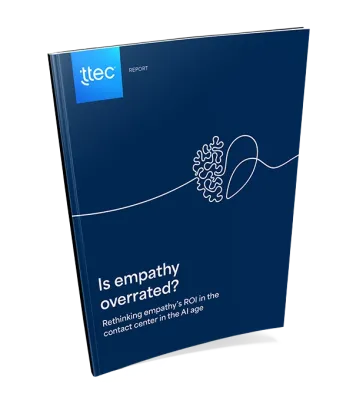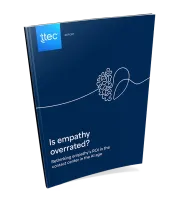The competition for good talent is the fiercest it has ever been for contact centers. Workers have their pick of low-wage jobs, thanks to near-record unemployment rates, remote employment options, and changing tax liabilities from the new U.S. tax plan. Minimum-wage laws mandate higher wage floors, and once you get good workers, it’s a constant struggle to keep them.
The issue is exacerbated by a fundamental shift occurring in customer interactions. Customers expect digitally enabled experiences across channels, which add to the need for highly skilled, expert employees to serve them. The days of sole “butts-in-seats” voice volume considerations are over.
The answer to the problem is simple: Pay workers better and provide them an environment where they want to stay.
Okay, it isn’t that simple. Or is it? Your associates are the front line of your business. They are your brand ambassadors who interact with your customers every day. They can make or break customer loyalty and influence revenues, costs, and overall corporate financial health. Yet the industry, built on cost containment, is still focused on how inexpensively to run contact center operations. The value of these employees is often lost in operational conversations.
If you treat employees as valuable assets with higher pay and a more supportive work environment, you will attract better quality associates, they will stay longer, and they will provide better service. In the long run they will cost you less than if you pay lower wages because they will stay longer and improve their skills over time.
The average wage for a U.S. contact center representative is $13.14 per hour, according to research from compensation company PayScale. In our experience, we have found that even slight increases above market averages will attract better candidates who will be more likely to stay, both in the U.S. and elsewhere. Associate tenure increases, which leads to a range of other performance and customer KPIs.
The Business Process Outsourcing (BPO) business is based on the efficiencies of labor augmentation. It’s a space we’ve been operating in for 35 years. And we see that investing up front in talent is the most efficient way to simultaneously improve your customer experience and your bottom line. Attrition is a profitability killer. If you can stem attrition, you can fund the pay increases easily. And when you add in the productivity gains from automation, AI/ML, and channel shifts, it is a no-brainer.
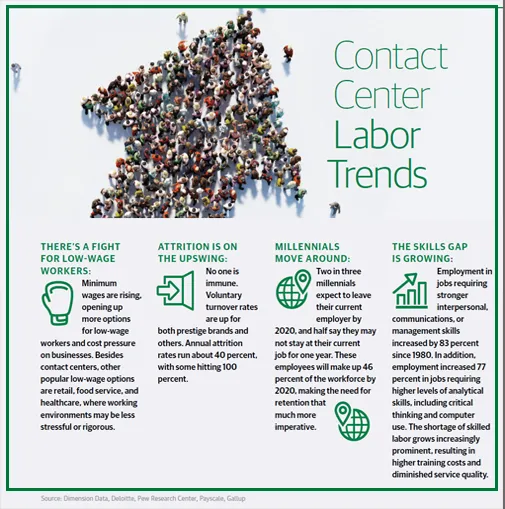
That doesn’t mean you need to vastly increase your contact center budget. Thanks to new technologies and insights, you can get so much more out of your contact center operations with nearly the same budget by shifting how the money gets allocated. It will free up money to invest in hiring, training, and keeping employees, while at the same time improve operations to be more efficient and pleasant for customers.
The money is there in your contact center to be used to attract and retain the best workers. So how do you get it? A few best practices show where there is money to be saved, through thinking about your operations differently.
1. Balance automation with humans to deliver better, more valuable experiences with fewer people.
Adoption of AI/ML and automated interactions are rapidly rising. Gartner predicts that by 2020 a customer will manage 85 percent of the relationship with an enterprise without interacting with a human. In the context of labor, McKinsey forecasts that 51 percent of U.S. business operations have the potential to be automated, accounting for almost $2.7 trillion in wages.
We are nearly at the tipping point from automation as hype to business-as-usual. One-third of contact center executives say that AI and robotic process automation (RPA) have matured enough to justify strategic investment by 2019, according to Deloitte. And Microsoft reports that 90 percent of consumers now expect a brand or organization to offer a self-service customer support portal.
Automation and customer self-service tools can ease the human burden for supporting repeatable, simple, transactional interactions. Save your people for interactions that are complicated, highly valuable, or fueled by emotion. The goal is to create “do no harm” automation policies and processes that free up human resources to focus on higher-value interactions. It can’t just be a cost savings decision.
Financial impact:
The cost savings potential of automation is impressive. Salesforce estimates the costs of different channels. Notice the huge drop in costs when moving to automated solutions:
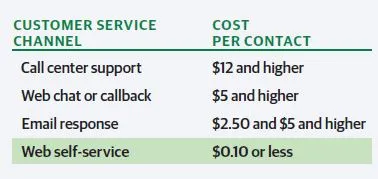
2. Use analytics to hire, onboard, and train employees more effectively.
When margins are tight, the ability to gather insights about associates early on about their future potential is a critical asset.
From talent acquisition through the employee lifecycle, data-driven insights can fuel employee performance, satisfaction, and retention throughout the associate hiring, training, and development lifecycle. And having happy, knowledgeable, invested employees more easily translates into increased customer satisfaction. Both historical and predictive insight can enhance a company’s ability to create productive, engaged workers.
For example, in the recruitment phase, talent acquisition leaders can determine the most predictive pre-hire characteristics of future employees, based on common attributes of their most successful associates, such as education and high levels of empathy. In the training and development phases, employee or trainer performance metrics can be analyzed to find positive and negative outliers in performance during training and in live environments. The curriculum can be modified based on performance and on how effective the methods are in both training and the live environment. And retention analysis can help companies focus on the rewards or recognition associates enjoy most (bonuses, days off, longer breaks, control over schedule); who is likely to attrite and when; and where there are training gaps that hinder upward employee mobility.
Financial impact:
Getting smarter about hiring and training leads to cost savings and potential revenue in a number of areas:
• By identifying top performer potential, talent acquisition departments can target only select recruiting channels and solicit proactive employee referrals from top performers, saving the costs of finding people.
• Retention among top performers can save turnover costs ranging from 60 to 200 percent of salary.
• Preventing bad hires save anywhere from $25,000 to $50,000 per year.
• Reduced vacancy means increased productivity and more revenue potential.
3. Eliminate waste from contact center operations.
Zeroing in on inefficiencies that slow down operations and cause friction in the customer experience can help companies identify areas that constrain to their long-term growth, scalability, and ultimately profitability. The good news for companies interested in improving their operations is that even small, incremental changes can make a big difference.
Call deflection strategies help eliminate “bad volume” by reducing redundant calls or pre-empting calls with proactive outreach before a customer needs to pick up the phone. Frequent caller activity analysis can identify common issues in products, services, or customer experiences that may be fixed to prevent future calls. Simple changes to associate scripts, website text, or app tools may reduce handle time and increase resolution rates. And operational assessments can look at the entirety of the customer interaction to see what can be streamlined.
Taking it a step further, customer journey orchestration programs design, implement, and manage all the steps a customer has with your company, in various channels. Deciding which of these touchpoints can be automated, which can be streamlined, and which can be eliminated will also reduce waste in effort and money.
Financial impact:
Process improvements at a wireless company led to a 20 percent improvement in average handle time, and accompanying Lean Six Sigma Green Belt projects are on pace to deliver $10 million in total financial savings.
According to the Society of Human Resources Management (SHRM’s) Employee Job Satisfaction and Engagement report, the single biggest contributor to employee retention is “respectful treatment of all employees at all levels.” Competitive compensation and benefits are the first step to showing that you value front-line associates as essential employees. The report further states that “although employees do place importance on financial features of a job such as pay and benefits, they consider culture and connection to be of utmost importance.” Without feeling connected to the organization, they are ripe for attrition.
Contact center associates leave most often for similar reasons: They find better opportunities elsewhere, they feel powerless, don’t see a career path, or they find the work boring and unfulfilling, according to ICMI research. At their core, these reasons prove that associates leave when they don’t feel valued.
Most contact centers essentially operate in the same factory approach they did 30 years ago, even as businesses all around them evolve to be more employee-centric.
Take contact center cost savings and efficiency gains from automation, process improvements, and talent acquisition/retention and re-invest it in your people. There will always be a need for people in the customer experience space even if their positions don’t look the same tomorrow as they do today.
How much to shift toward employee initiatives and wages depends on individual financial and operational situations. It depends on the priorities of the business. Some companies will profit from slight adjustments, while others may overhaul their entire workspace, benefits options, and wage scales.
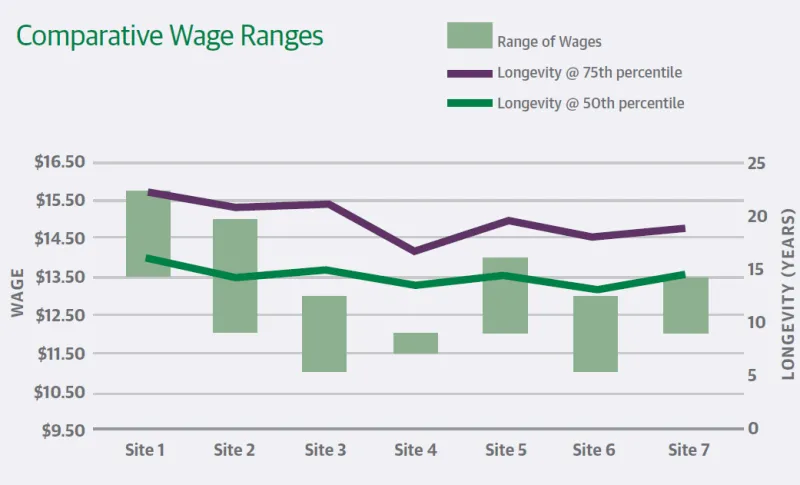
The accompanying chart plots wage ranges at different sites, along with associate tenure. It can help to illustrate the likely impact higher wages will have on tenure, which cascade to other improvements.
Case in point
This premise was recently applied by a financial services client. Correlating performance metrics with wage analysis, we determined that the client would reduce attrition, increase tenure, boost associate performance, and improve customer experience with a fixed wage increase, supplemented with a robust pay-for-performance plan. And revenue from the improvements was estimated to exceed the compensation increase by over 200 percent. It was up to the client to determine how far to take the program.
We gave the client three options, with a range of benefits for each option. It chose a plan that could deliver the following KPIs:
- 10% increase in customer satisfaction (CSAT)
- 12% decrease in Average Handle Time (AHT)
- 31% reduction in production attrition
Performance improvements were met within 90 days of the implementation and showed additional sustained increases. Attrition results were met within 180 days. And three years after the compensation increase, employees continue to exceed performance levels. They have remained as the top performers in the client’s supplier and internal network for top call types.
Conclusion
The stakes are high for contact centers in this volatile labor market. The fight for the best talent is ongoing. Leaders know that the status quo is not an option. Don’t be afraid to invest differently so that your associates—the most valuable asset of your contact center—are paid to reflect the amount of company and customer value they generate.

